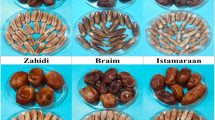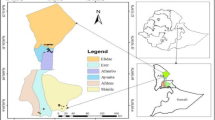Abstract
Phoenix dactylifera L. has about 400 date palm cultivars in Iran with very confined information on their genetic structure and content. Up to now, our date palm cultivation has been based on traditional approached and therefore we need to move towards modern approaches of molecular breeding and biotechnology. The present study was performed on 113 date palm trees of 13 known cultivars, cultivated in different regions of Iran. We used SCoT molecular marker for our genetic investigation with the following aims: 1—Investigate genetic diversity both among and with date palm cultivars, 2—Identify genetic groups within these 13 cultivars, and 3—produce data on the genetic structure of date palm cultivars. The results obtained revealed a high within-population genetic variability. The studied cultivars differed genetically as evidenced by analysis of molecular variance and Fst values obtained in STRUCTURE analysis. Gene flow and genetic admixture were observed among date palm cultivars. No association occurred between geographical distance and genetic distance of date palm populations studied. The results indicated the efficiency of SCoT markers in genetic diversity analysis and genetic fingerprinting of date palms. Similarly, data obtained may be used in future breeding and hybridization programs of Iranian date palms.





Similar content being viewed by others
Data archiving statement
All tree samples used in this research are being archived in Herbarium of Shahid Beheshti University, Tehran, Iran. The accession numbers will be supplied once available.
References
Al-Qurainy F, Khan S, Al-Hemaid FM, Ali MA, Tarroum M, Ashraf M (2011) Assessing molecular signature for some potential date (Phoenix dactylifera L.) cultivars from Saudi Arabia based on chloroplast DNA sequences rpoB and psbA-trnH. IJMCFK 12:68–71
Al-Qurainy F, Khan S, Nadeem M, Tarroum M (2015) SCoT marker for the assessment of genetic diversity in Saudi Arabian date palm cultivars. Pak J Bot 47:637–643
Arabnezhad H, Bahar M, Reza Mohammadi H, Latifian M (2012) Development characterization and use of microsatellite markers for germplasm analysis in date palm (Phoenix dactylifera L.). Sci Hortic 134:150–156
Bahraminejad A, Mohammadi-Nejad GH (2015) Genetic diversity analysis of date palm (Phoenix dactylifera L.) genotypes using RAPD markers. ARRB 5:41–47
Collard BCY, Mackill DJ (2009) Start codon targeted (SCoT) polymorphism: a simple novel DNA marker technique for generating gene-targeted markers in plants. Plant Mol Biol Rep 27:86–93
Elmeer K, Mattat I (2015) Genetic diversity of Qatari date palm using SSR markers. Genet Mol Res 14(1):1624–1635
Elshibli S, Korpelainen H (2008) Microsatellite markers reveal high genetic diversity in date palm (Phoenix dactylifera L.) germplasm fromSudan. Genetica 134:251–260
Evanno G, Regnaut S, Goudet J (2005) Detecting the number of clusters of individuals using the software STRUCTURE: a simulation study. Mol Ecol 14:2611–2620
Falush D, Stephens M, Pritchard JK (2007) Inference of population structure using multilocus genotype data: dominant markers and null alleles. Mol Ecol Notes 7:574–578
Freeland JR, Kirk H, Peterson SD (2011) Molecular ecology, 2nd edn. Wiley-Blackwell, London, p 449
Hajian S, Hamidi-Esfahani Z (2015) Date palm genetic resources and utilization. In: Al-Khayri J, Jain SM, Johnson D (eds) Asia and Europe. Springer, Berlin, pp 19–47. https://doi.org/10.1007/978-94-017-9694-1
Hamer ØM, Harper DAT, Ryan PD (2012) PAST: paleontological statistics software package for education and data analysis. Palaeontol Electron 4:9
Jaradat AA (2015) Date palm genetic resources and utilization. In: Al-Khayri J, Jain SM, Johnson D (eds) Africa and the Americas. Springer, Berlin, pp 208–217
Jaradat AA, Zaid A (2004) Quality traits of date palm fruits in a center of origin and center of diversity. JFAE 2:208–217
Karim K, Chokri B, Amel S, Wafa H, Richid H, Nouredine D (2010) Genetic diversity of Tunisian date palm germplasm using ISSR markers. Int J Bot 6:182–186
Krisman M, Jakše J, Barièeviè D, Javornik B, Prošek M (2006) Robust CTAB-activated charcoal protocol for plant DNA extraction. Acta Agric Slov 87:427–433
Luo CXH, He H, Chen SJ, Ou MP, Gao JS, Brown CT, Tondo R, Schnell J (2011) Genetic diversity of mango cultivars estimated using SCoT and ISSR markers. Biochem Syst Ecol 39:676–684
Meirmans PG, Van Tienderen PH (2004) genotype and genodive: two programs for the analysis of genetic diversity of asexual organisms. Mol Ecol Notes 4:792–794
Mosafari M, Mehrabi AA (2013) Molecular identification and geneticdiversity of Iranian date palm (Phoenix dactylifera L.) cultivars using ISSR and RAPD markers. AJCS 7:1160–1166
Peakall R, Smouse PE (2006) GENALEX 6: genetic analysis in Excel. Population genetic software for teaching and research. Mol Ecol Notes 6:288–295
Podani J (2000) Introduction to the exploration of multivariate data. Backhuys Publishers, Leiden
Pritchard JK, Stephens M, Donnelly P (2000) Inference of population structure using multilocus genotype data. Genetics 155:945–959
Rhouma S, Mohamed Salem AO, Zehdi-Azouzi S, Chatti K.Rhouma A, Marrakchi M, Trifi M (2009) Comparative analysis of genetic diversity in Tunisian date-palm (Phoenix dactylifera L.) as revealed by RAPDs and AFLPs. In: Socias i Company R, Espiau MT, Alonso JM (eds) XII EUCARPIA symposium on fruit breeding and genetics, ISHS, Acta Horticulturae, pp 814
Sawant SVPK, Singh SK, Gupta R, Madnala TuliR (1999) Conserved nucleotide sequences in highly expressed genes in plants. J Genet 78:123–131
Sharifi M, Sheidai M, Koohdar F (2018) Genetic fingerprinting of date palm (Phoenix dactylifera L.) by using ISSR and cpDNA sequences. Indian J Genet 78:507–514
Wafa M, Aladadi L, Mahmoud F, Moustafa S, Alruman A (2018) Genetic variability among seven cultivars of date palm (Phoenix dactylifera L.) based on embryonic DNA of old fruit Kuwait. J Sci 45:108–114
Weising K, Nybom H, Wolff K, Kahl G (2005) DNA Fingerprinting in Plants: principles, methods, and applications, 2nd edn. Boca Raton, CRC Press, USA
Wu JM, Li YR, Yang LT, Fang FX, Song HZ, Tang HQ, Wang M, Weng ML (2013) cDNA-SCoT: a novel rapid method for analysis of gene differential expression in sugarcane and other plants. AJCS 7:659–664
Acknowledgements
We acknowledge Science and Research Branch, Islamic Azad University for providing laboratory. We thank the Iran National Science Foundation (INSF), for partial financial support of this project (No. 97010700).
Author information
Authors and Affiliations
Contributions
ZN: conceptualization of the project; MSh: analyses of data; SS: data collection and lab work; SM: providing samples; ZN, MSh SM and SS project design
Corresponding author
Ethics declarations
Conflict of interest
The authors declare that they have no conflict of interest.
Additional information
Publisher's Note
Springer Nature remains neutral with regard to jurisdictional claims in published maps and institutional affiliations.
Rights and permissions
About this article
Cite this article
Saboori, S., Noormohammadi, Z., Sheidai, M. et al. SCoT molecular markers and genetic fingerprinting of date palm (Phoenix dactylifera L.) cultivars. Genet Resour Crop Evol 67, 73–82 (2020). https://doi.org/10.1007/s10722-019-00854-x
Received:
Accepted:
Published:
Issue Date:
DOI: https://doi.org/10.1007/s10722-019-00854-x




